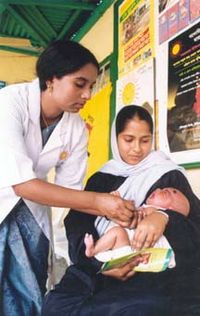
Photo from wikipedia
INTRODUCTION We aimed to describe the clinical characteristics, diagnostic challenges, treatment patterns and outcomes of uveal melanoma (UM) in a tertiary care centre. METHODS This is a retrospective case series… Click to show full abstract
INTRODUCTION We aimed to describe the clinical characteristics, diagnostic challenges, treatment patterns and outcomes of uveal melanoma (UM) in a tertiary care centre. METHODS This is a retrospective case series of 11 consecutive patients with UM who were managed in a tertiary referral centre between 2002 and 2017. Epidemiological, clinical, pathological and radiological characteristics were reviewed. Classification of choroidal melanoma as small, medium or large was based on the criteria established by the Collaborative Ocular Melanoma Study. RESULTS Mean age at presentation was 42.9 (range 27-67) years. In 7 (64%) patients, a definitive diagnosis of UM was made after a mean follow-up period of 6.4 (range 1-17) months. There were one, six and four patients with small-, medium- and large-sized choroidal melanomas, respectively. Treatment was enucleation in 5 (45.5%) patients, plaque brachytherapy in 4 (36.4%) patients, transpupillary thermotherapy in 1 (9.1%) patient, and observation in 1 (9.1%) patient. Median follow-up was 29 months. Metastatic disease developed in 5 (45.5%) patients at the mean age of 46.6 (range 38‒56) years, with median overall survival of 20 months. Genetic mutations in three patients were monosomy 3 (n = 2), and gain of 3q and 8q (n = 1). CONCLUSION Our study supports the finding that UM in Chinese and Asian-Indian patients presents at a younger age than in Caucasians. Although rare, ophthalmologists should remain mindful of this life-threatening disease. We propose a national and regional registry for ocular tumours with genetic information to characterise the disease spectrum in Southeast Asia.
Journal Title: Singapore medical journal
Year Published: 2019
Link to full text (if available)
Share on Social Media: Sign Up to like & get
recommendations!